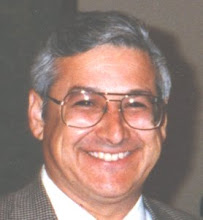Emeterio R. Jiménez, died September 2, 2010 at Doctor's Hospital in Laredo, Texas.
Mr. Jiménez lived in Laredo all his life. He was born in Laredo on May 19, 1918 to Pedro and María Rivero Jiménez.
During WWII Mr. Jiménez served in the Army during the occupation of Germany (99th Infantry Division, 394th Infantry Regiment). After the war he worked at the Laredo Air Force Base for more than 20 years. After retirement, he worked more than 20 years at the Laredo National Bank. He had been an active member of San Luis Rey Church. He loved his family and treasured life. He was a mild man with no enemies.
Mr. Jiménez was preceded in death by his parents, his wife Dora Martínez Jiménez, and his 2 brothers Manuel (Mélida) Jiménez and Roberto (Irma) Jiménez.
Mr. Jiménez is survived by 3 daughters and 2 sons: Antonio Jiménez (Emma), Yolanda Cuesta (Lorenzo), Rosario Lozano (Nelson), Gerardo Jiménez (Carmen), and Imelda Salinas (Paul).
He had 10 grandchildren: Jose Antonio Jiménez, Guadalupe Cadena (??), Clarisa Lozano, Javier Lozano (Adriana), Mónica Gómez, Gerardo Jiménez, Josué Jiménez, Alejandro Jiménez, César Herrera, and Julio Javier Herrera. He also had 2 great granddaughters (Isabella Lozano and Athalia Cadena), and numerous nephews and nieces.
The funeral services were held at 4:00 p.m. on September 6, 2010 at the López Hernández Funeral Home. The grandchildren presented various eulogies. Church services were held on September 7, 2010 at 9:30 a.m. at San Luis Rey Church in Laredo, Texas. Interrment was in the Veterans' Section of the City Cemetary. Full Military Honors, including a Flag Presentation detail from Ft. Sam Houston and a 21 gun salute by members of the VFW Post #59 of Laredo, were presented as all the cemetery's flags were flown at half mast.
Emeterio Jiménez
My father-in-law had a way of bring calmness into a room by merely entering the room. Other times he would enter a room with a huge smile, a warm greeting for everyone, and a contagious chuckle.
When he got home from a long day at work, he would sit down to listen attentively to his kids babble on and on endlessly about their day. When his kids misbehaved and were punished to the bedroom, the children knew that father would come home soon and rescue them, because all punishments were suspended once he arrived home from work.
If one of his kids or grandkids was crying, he would start an animated conversation with the child, interrupting it with belly laughs. Within a few minutes the child would forget the tears, dive into the conversation, and laugh as only a happy kid can laugh.
During serene summer evenings, I remember listening to him play his guitar and sing boleros from the type of music and lyrics that have meaning.
I knew him for almost 50 years and I cannot remember a day when he raised his voice, displayed anger, or wished anyone ill will. He was a mild humble man that had no enemies. He pampered his grandkids, adored his children, and loved his wife.
Emeterio, my dear friend, we will miss you with every tear and every joy that memories of you will cause us. But be patient. Soon, we will all be together again.
Emeterio Jiménez
Mi suegro tenía la gracia de poder llenar una habitación con calma y serenidad. En otras ocasiones entraba a una habitación con un sonrisota traviesa, saludando a todos, y contagiándonos con su risa cariñosa.
Después de un día largo de trabajo, llegaba a su casa y se ponía a escuchar con mucha paciencia a una de sus hijas hablar de cosas de niñez. Si sus hijas se portaban mal y su mamá las castigaba a la recamara, las hijas sabían bien que el papá las salvaría del castigo, porque en esa casa los castigos se anulaban cuando él llegaba del trabajo.
Varias veces observé como resolvía las lágrimas de una niña o una nieta. Levantaba a la niña platicándole de tonterías en voz animada y carcajeándose. La niña se olvidaba de las lágrimas, le seguía la conversación, y se reía como solo una niña alegre sabe reír.
Me acuerdo que en noches serenas de verano tomaba su guitarra y cantaba boleros de aquellos que tenían letra y música de mucho sentimiento.
Conocí a mi suegro por casi 50 años. Nunca lo oí alzar la voz con coraje, nunca mostró odio, nunca le deseó mal a nadie. Mi suegro fue un hombre modesto y sereno que nunca tuvo un enemigo. Siempre mimó a sus nietos, adoró a sus hijas, y amó a su esposa.
Emeterio, amigo mío, te extrañaremos con cada lágrima y cada risa que nos cause tu memoria. Pero espera, porque pronto estaremos contigo.












